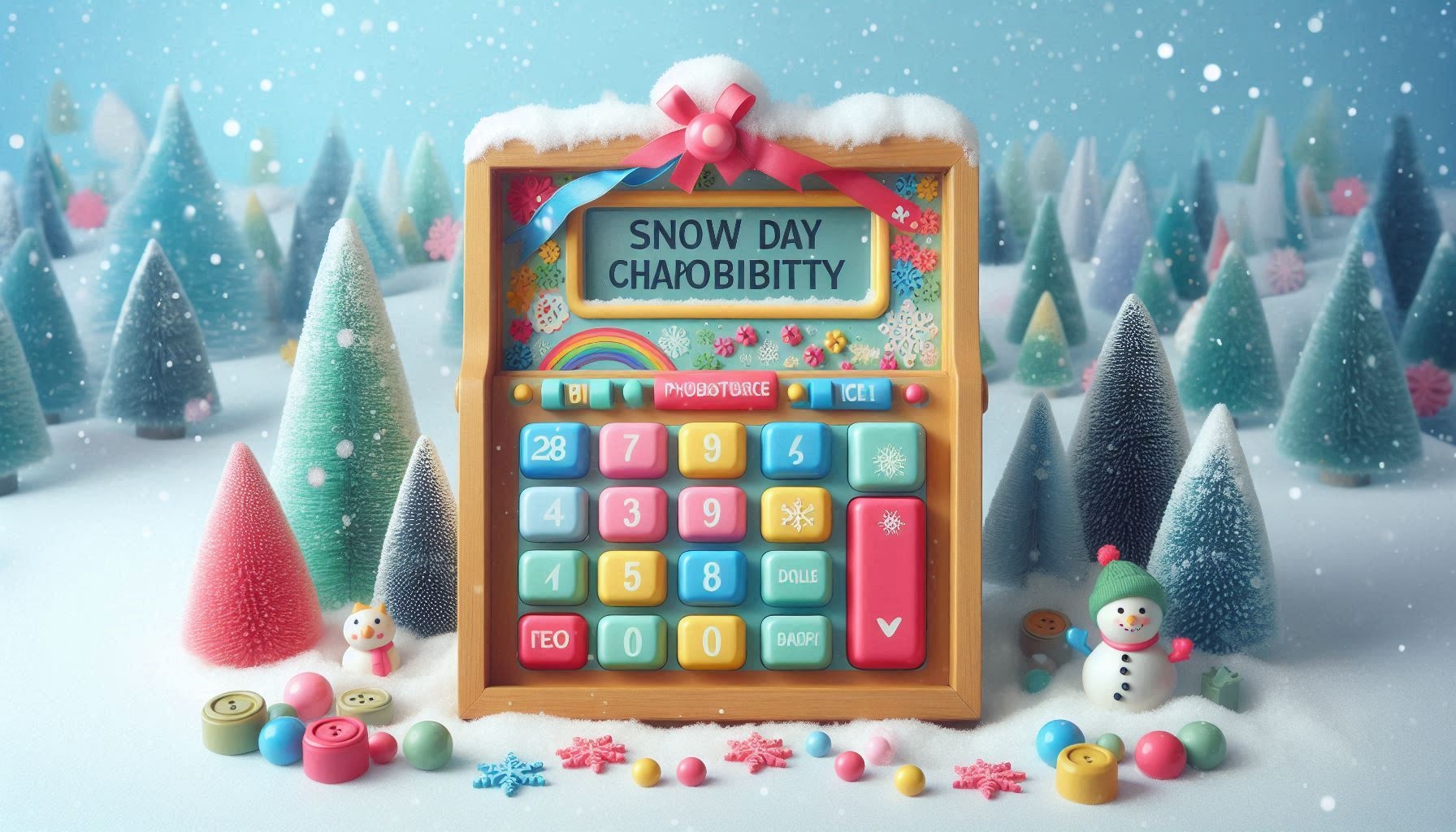Snow Day Percentage Calculator: Predict Your Chance of a Snow Day

Introduction
Winter brings the excitement of snow-covered landscapes, cozy days indoors, and—most importantly—the possibility of a snow day. Whether you're a student hoping for a day off school or a parent planning for childcare, predicting the likelihood of a snow day can be incredibly useful.
A Snow Day Percentage Calculator helps estimate the probability of school or work closures based on weather forecasts, historical data, and local policies. In this guide, we'll explore how these calculators work, factors influencing snow day decisions, and how you can create or use one to stay ahead of winter weather.
What Is a Snow Day Percentage Calculator?
A Snow Day Percentage Calculator is a tool that estimates the likelihood of a snow day based on various weather and logistical factors. These calculators analyze:
-
Forecasted snowfall amounts
-
Temperature trends
-
Wind speed and wind chill
-
Road conditions and local plowing efficiency
-
School district or employer policies
By inputting these variables, the calculator generates a percentage chance that schools or businesses will close due to severe winter weather.
Why Use a Snow Day Calculator?
-
Plan Ahead – Avoid last-minute disruptions by anticipating closures.
-
Student & Parent Convenience – Prepare for childcare or remote learning days.
-
Work Flexibility – Employees can arrange remote work if commuting is unsafe.
-
Fun & Predictions – Gamify winter weather by tracking predictions with friends.
How Snow Day Calculators Work
Most snow day calculators use a combination of historical data and real-time weather forecasts to generate predictions. Here’s how they typically function:
1. Input Key Weather Data
-
Snowfall Prediction (inches/cm) – The more snow expected, the higher the chance of a closure.
-
Temperature (°F/°C) – Extremely low temperatures increase the likelihood of delays or closures.
-
Wind Speed & Chill – High winds can create dangerous conditions, even with less snow.
-
Timing of Snowfall – Morning snowstorms are more likely to cause closures than overnight snow.
2. Local Policy Factors
-
School District Thresholds – Some districts close at 6+ inches, while others may stay open.
-
City Snow Removal Efficiency – Areas with slow plowing are more prone to closures.
-
Public Transportation Impact – If buses can't run safely, schools may close.
3. Historical Closure Trends
-
Past decisions from your school or workplace can indicate future behavior.
-
Some calculators use machine learning to improve accuracy over time.
4. Calculating the Probability
A basic formula might look like:
Snow Day Chance (%) = (Snowfall Factor + Temperature Factor + Wind Factor) × Policy Adjustment
More advanced models use weighted algorithms for higher accuracy.
Top Snow Day Percentage Calculators Online
Several websites and apps offer snow day predictions. Here are some popular options:
1. Snow Day Calculator (snowdaycalculator.com)
-
One of the most well-known tools.
-
Uses ZIP code-based weather data and historical trends.
-
Provides a percentage chance and a "Likely" or "Unlikely" rating.
2. Pivotal Weather Snow Day Predictor
-
Focuses on real-time storm tracking.
-
Great for major winter storms.
3. Local News & Weather Apps
-
Many local meteorologists provide school closure predictions.
-
Examples: The Weather Channel, AccuWeather.
4. DIY Snow Day Calculator (Google Sheets/Excel)
-
Create your own using weather APIs and simple formulas.
How to Make Your Own Snow Day Calculator
Want to build a custom Snow Day Calculator predictor? Here’s a simple way to do it:
Step 1: Gather Data
-
Use National Weather Service (NWS) forecasts or OpenWeatherMap API.
-
Track past closures in your area.
Step 2: Assign Weights to Factors
Example weights:
-
Snowfall (50%) – 0-2" (10%), 2-4" (30%), 4-6" (60%), 6"+ (90%)
-
Temperature (20%) – Below 10°F increases closure odds.
-
Wind (10%) – Gusts over 20 mph add risk.
-
Timing (20%) – Snow starting at 5 AM vs. overnight.
Step 3: Build the Formula
= (Snowfall% × 0.5) + (Temperature% × 0.2) + (Wind% × 0.1) + (Timing% × 0.2)
Step 4: Test & Improve
Compare predictions with actual closures and adjust weights accordingly.
Factors That Increase Snow Day Chances
-
Heavy Snow (6+ inches) – Most districts close.
-
Ice & Freezing Rain – More dangerous than snow.
-
Extreme Cold (-10°F or below) – Risk of frostbite & bus failures.
-
Early Morning Snow – Less time for plows to clear roads.
-
Rural Areas – Slower road treatment than cities.
Factors That Decrease Snow Day Chances
-
Light Snow (1-3 inches) – Often not enough for closures.
-
Weekend Snowstorms – No impact on school schedules.
-
Cities with Strong Plowing Systems – Faster cleanup.
-
Virtual Learning Policies – Some schools switch online instead of closing.
Fun Ways to Use a Snow Day Calculator
-
Compete with Friends – Who predicted the snow day correctly?
-
Track Winter Trends – See which months have the most closures.
-
Plan Snow Activities – If a snow day is likely, prep sleds and hot cocoa!
Conclusion
A Snow Day Calculator is a fun and practical tool for predicting winter weather disruptions. Whether you use an online calculator or create your own, understanding the key factors—snowfall, temperature, wind, and local policies—can help you stay prepared.
- Questions and Answers
- Opinion
- Motivational and Inspiring Story
- Technology
- True & Inspiring Quotes
- Live and Let live
- Focus
- Geopolitics
- Military-Arms/Equipment
- Art
- Causes
- Crafts
- Dance
- Drinks
- Film/Movie
- Fitness
- Food
- Giochi
- Gardening
- Health
- Home
- Literature
- Music
- Networking
- Altre informazioni
- Party
- Religion
- Shopping
- Sports
- Theater
- Wellness
- News
- Culture

